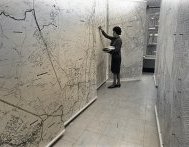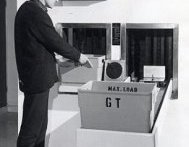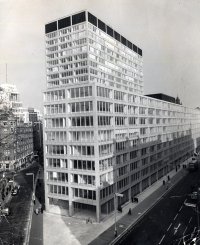 The Metropolitan Police has sold its home since 1967, pictured, for £370 million to Abu Dhabi investors
The Metropolitan Police has sold its home since 1967, pictured, for £370 million to Abu Dhabi investors
However, the iconic revolving sign, pictured, which a tourist favourite, will move to the new building in 2016
The Metropolitan Police will move into their new headquarters building, pictured, within the next two years
The operational HQ will be moved to the Curtis Green building, which is currently being refurbished at a cost of £58 million.
It is estimated that the new headquarters should save the Met some £6 million in running costs.
Mayor of London Boris Johnson said the new Met HQ was a 'pretty nondescript building...a lovely building obviously'.
He said that while New Scotland Yard would be redeveloped, the 'special triangle jobby' - the revolving sign outside - would be kept.
SCOTLAND YARD: ON THE MOVE
The Metropolitan Police moved to its current location beside St James' Park station in 1967.
![]() After Robert Peel founded the Metropolitan Police in 1829, the new police force had its headquarters in Whitehall Place.
After Robert Peel founded the Metropolitan Police in 1829, the new police force had its headquarters in Whitehall Place.
The rear of this property faced a court yard which led onto Great Scotland Yard.
The name Scotland Yard attached itself to the headquarters building.
In 1890, the Met moved to the Norman Shaw building in 1890, which was named 'New Scotland Yard'.
The Met retained the name 'New Scotland Yard' when it moved to its latest home in 1967.
The first ever 'police procedural' television show Fabian of the Yard was broadcast by the BBC between 1954 and 1956. It was based on the memoirs of real-life Scotland Yard detective Robert Fabian.
He added: 'The Met Police has a unique place in history and they need a home fit for the future, but police budgets are under real pressure.
'The sale of this under-used and outdated building means we can now not only protect that rich heritage, but also fund the new HQ and kit out bobbies with the latest mobile technology to secure the future of the force.
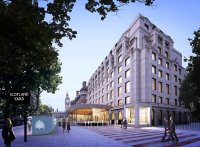 'This landmark deal allows us to preserve the past whilst giving today's Met a vital cash boost so our officers can go on keeping London safe.'
'This landmark deal allows us to preserve the past whilst giving today's Met a vital cash boost so our officers can go on keeping London safe.'
Jassim Alseddiqi, chief executive of ADFG, said: 'Ten Broadway will be one of the most important redevelopment projects undertaken in Central London this decade, replacing a world famous headquarters with a world class development.
'With the bid process now complete, we look forward to creating an exceptional new landmark for London.'
Once redeveloped and sold, the Victoria Street site is projected to yield up to £100 million in stamp duty receipts for the UK Exchequer.
The sale is part of an ongoing overhaul of the Met estate which has so far raised £215 million through the sale of 52 under-used and outdated buildings.
When completed in 2016, the restructure is predicted to save London's police force over £60 million in annual running costs - enough to fund 1, 000 officers - and will leave behind a smaller, more modern estate which will include a new training facility in Hendon and a world-class forensics lab and control centre in Lambeth.
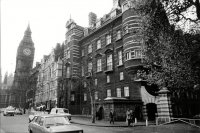 The Met moved into the first 'New Scotland Yard', pictured, in 1890 after leaving their Whitehall home
The Met moved into the first 'New Scotland Yard', pictured, in 1890 after leaving their Whitehall home
At the time of its opening in 1967, New Scotland Yard, pictured, was seen as a state-of-the art location
But over the past 40 years, the building has become a liability and was described as not fit for purpose
It will be moved to the Met's new HQ - the Curtis Green building on Victoria Embankment, which will continue to be known as Scotland Yard.
As the home of the Met, Scotland Yard has moved several times before - from Whitehall Place to Great Scotland Yard in 1875, to the Norman Shaw building in 1890 and to the current building in 1967.
This new move therefore marks a return to nearer its founding location.
The current HQ is home to many unique artefacts and policing memorabilia dating back to the formation of the Metropolitan Police in 1829 - none of which are currently on public display.
The additional proceeds from the sale means a small portion of money raised can be used to relocate this collection to a dedicated museum site, allowing visitors to see rare crime artefacts and heritage items that tell the history of Scotland Yard.
